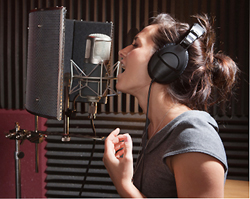Whether you’re a voiceover artist, songwriter, or rapper, chances are at some point you will be interested in setting up a personal recording system.
For some people, simply getting the idea in a recorded fashion is enough. Others may want to actually release or sell the results.
But getting started can be a little daunting. Have no fear, I’m here to help.
The goal here will be two fold – to get workable, decent results, and to not break the bank.
Here’s what you basically need:
1) Voice
It all starts here. A rich, strong vocal tone will translate well even on a low budget setup.
2) Space
You exist in a physical environment, and there’s no way to take that out of the equation. The most common error people make here is to record in the smallest space possible.
This is done because (a) you don’t hear as much reverberation in smaller spaces, and (b) because that somehow came into fashion. This is rarely the best setup.
You’re much better off using a medium sized room and creating some kind of gobo system. That could be those overpriced Auralex gobos, or you can make your own. The cheapest way is to mount up some moving blankets using mic stands or any other support system.
For just a hair more money and a little more effort, you can do it using Owens Corning 703 fiberglass wrapped in fabric or burlap. The trick here is that you don’t put the gobos behind the mic. You put them behind yourself, generally in some kind of triangle configuration. This takes the most effort to get right – but for around $100, you’ll get much more distance from even a cheap setup.
A cheap mic in a room with gobos will sound better than an expensive mic in a closet, 9 times out of 10. So take the time, do some research, and get this step right!
3) Microphone
You need to turn your acoustic voice into voltage. If you are doing voice over or rap I recommend going with a condenser microphone. Even in the $300 price range, there are some very good options.
My personal favorite is the Audio-Technica 4033a. This is a microphone that holds it’s own against microphones that cost 10x as much. You can get very professional results on this mic.
But there are a number of options in this range that are good. I’m not a fan of the Rode NT1-A, which seems to be among the most popular picks. They give good results, but they tend to require a little more skill on the mixing end to get the best out of them. Also, microphone placement matters.
If you’re a singer, you may want to try a dynamic microphone like a Shure SM7 or an Electro-Voice RE20. These microphones have been used on countless classic albums and give killer results that rival high end condenser mics.
The only reasons I hesitate to recommend these microphones to voiceover artists and rap artists is that they don’t have the most open/natural top end (important for a voice over, to hear the “reality” of the voice), and they tend to round out the transient sounds hitting the diaphragm (not as much articulation for fast rap vocals).
That said I’ve record rap vocals with an SM7 quite successfully, so these things are fairly negotiable.



















